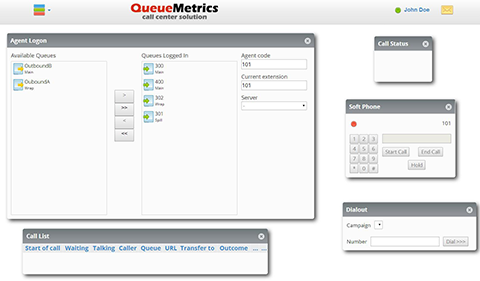QueueMetrics Training Program
Learn the essentials of QueueMetrics Asterisk Call-Center Suite with our training courses!
Our instructors will teach you how to install, configure and get the best from the most powerful monitoring and reporting tool in the Asterisk call-center industry.
Certification is included, allowing you to bring a new skill set to your job profile and company knowhow.

Discover QueueMetrics
QueueMetrics Training online course is designed to rapidly guide you through installation and basic configuration. Key reporting concepts are introduced and explained.
The course is example-based, with a focus on the practical knowledge required to successfully monitor your Asterisk PBX based call-center, create accurate real time and generate historical reports. Though some time is given to metrics explanation and theory, we've also included a lot of helpful information and examples.
We've left out the non-essentials so that you can get up-to-speed with QueueMetrics as fast as possible. The course includes references to online resources, including socials and video channels, for additional information and further learning.
Training Course Format
QueueMetrics Training is an online course. The 16 chapters include a total of approximately 4 hours of contents, plus a question-answer section at the end. This training does not need a physical classroom, students must install the proper chat system for the remote connection with the teacher.
Loway does not provide a Linux or an Asterisk training but students with even basic Asterisk skills should be able to follow along with the examples. QueueMetrics software must be also installed before the course begins.
This is an entry-level course, with no prerequisites to attend. However, you can buy a Custom Training Course for specific requests or advanced training. Customized training course can be tailored to meet the needs of your organization and include an array of different technical topics.
Write to  for information or
Buy Your Training Now!
for information or
Buy Your Training Now!
Course Outline
QueueMetrics Basics
An astonishing range of reports and the Real-Time panel, showing call center activities, are only part of the tools Loway provides, allowing you to take the concept of measuring to improve to a whole new level.
The best part is that there is no client-software installation, since QueueMetrics is designed to work within a browser. This means it can be accessed from anywhere as long as you possess the right credentials.
Last but not least, QueueMetrics is also highly customizable. You can fine tune almost every functionality to suit your needs, without having to undergo a long customization process.
Here we present an overview of QueueMetrics functionalities, logically divided in three categories.
- Administrative functionalities
- Supervising functionalities
- Agent-oriented functionalities
- Administrative functionalities
One of the major advantages of using QueueMetrics comes from the fact that it lets you define the components of your contact system, in a very simple yet powerful way.
QueueMetrics allows you to define the following components:
- Users
- Queues
- Agents
- Agents Groups
- Locations
- Pause Codes
- Outcome Codes
- Reports
An agent, instead, is a physical person in your call center. It doesn't need to be necessarily a user; if your agents are static in the queues and always use the same phones, you'd want to define the agents in QueueMetrics just to translate phone codes (e.g. SIP/3321) in a readable name in reports.
From the "Edit Outcome codes" you can define as many codes as you need.
Yet, you can define your custom Pause Codes and decide whether or not a pause code is related to a billable and/or payable activity. Then you can use this data in your reports to evaluate the productivity of the people working for you.
Supervising functionalities
- Reload: It defines the update period will be used to refresh the shown data
- Recap: Shows or hides the table containing the summary of calls by queue
- Calls: Shows or hides the Calls being processed table
- Agents: Shows or hides the Agents currently logged in table
- Queues: Shows all queues or only active queues
- Agents: Toggle between all agents or members only agents
- Location: If granted by user permissions, defines which location is shown
- Group: Defines wich agent group is shown
- Supervision: Filter out agents not supervised by current user
The quickest way to obtain an analysis is by selecting the queue and the report you want to analyze and then click on the appropriate time frame below the "Quick activity reports" title on the home page.
You can filter calls by:
- Date and time
- Queues
- Agents/Groups/Locations
- Outcome code
- Caller ID
- Specific days of the week or specific hours
and much more...
Agent-Oriented functionalities
- see their own status, i.e. whether they’re logged on or they’ve been disconnected
- see their last calls, including information like Caller ID, duration and waiting times
- see from which queue the call is coming, even if they lost the announcement message
- launch external web apps - like CRM software - that might be automatically linked to the Caller-ID or other information input by the caller
- read the messages broadcasted to him
- start a new conversation calling a phone number
- have a subset of AGAW information
- track information about the current call on QA forms
Also, it is possible to use this page to:
- Log the agent on and off to Asterisk and/or a specific queue
- Pause and un-pause the agent, entering the pause activity code if needed
- Set the outcome code for each call
By design you can add an outcome code within 30 minutes from the end of the call; after this time period it won't be possible to set an outcome code for the call.






